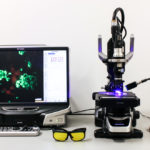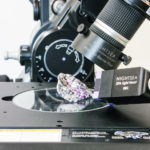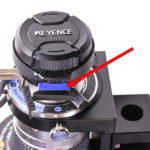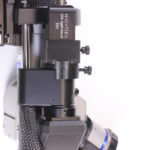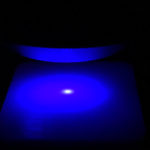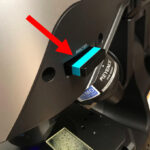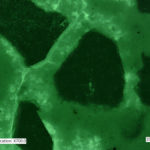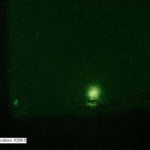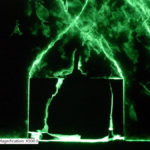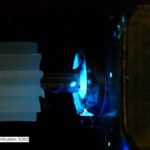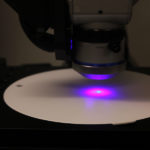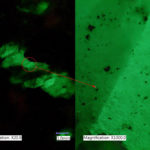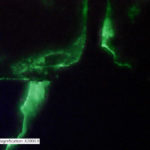Nightsea - Fluorescence Adapter for Keyence VHX Series Digital Microscope
The NIGHTSEA Model SFA Fluorescence Adapter system adds a versatile fluorescence imaging capability to the Keyence VHX series of digital microscopes. A growing number of Keyence owners are using the system successfully for a variety of applications. Visit our gallery of images made with the NIGHTSEA adapter and the Keyence microscope.
Fluorescence solutions for most Keyence lenses
Our adaptations to the Keyence system are concerned with the lens, not the microscope model (VHX-5000, -6000, ect.). We offer variants of our fluorescence adapter system that work with the most commonly used Keyence lenses – the VH-Z00, -Z20, -Z50, -Z100, -ZST, and with two of the lenses incorporated in the VHX-7100 Fully Integrated head (VHX-E20 and -E100).
The key elements of any fluorescence system are:
- a light source that produces sufficient energy in the appropriate wavelength range to excite fluorescence in the sample of interest;
- a barrier filter in the viewing path that blocks reflected excitation light while transmitting the fluorescence emitted by the sample.
NIGHTSEA implements these for the Keyence system with:
- high intensity LED light sources available in five excitation wavelength ranges (see list further down this page);
- emission barrier filters that can be easily added to the Keyence lenses.
The components of a NIGHTSEA system that adds a single excitation/emission wavelength combination on a Keyence microscope are:
- Flexible gooseneck lamp base with LED drive circuit and intensity control;
- Universal power supply (120/240VAC, 50/60Hz) with international plug set
- Excitation light source
- Emission barrier filter
- Barrier filter glasses for fluorescence viewing and eye safety
- Padded carrying case
Additional wavelength sets are implemented by adding a matched set (light plus filter set) consisting of a light source, barrier filter, and filter glasses.
Lens-specific solutions
The implementation approaches for the supported Keyence lenses are summarized here:
-
VH-Z00, -Z20, -Z50
- Light source – placed to the side of the microscope stage
- Barrier filter – slips over the bottom of the lens and attaches with thumbscrews
-
VH-Z100
- Light source – placed to the side of the microscope stage
- Barrier filter – inserts in the Analyzer slot at the top of the lens
-
VH-ZST
-
20-200 lens
- Light source – placed to the side of the microscope stage
- Barrier filter – inserts in the Analyzer slot at the top of the lens
-
200-2000 lens
-
Light source – mounts over the Keyence fiber optic input port (except for UV)
- provides enhanced performance at high magnification
- Barrier filter – inserts in the Analyzer slot at the top of the lens
-
Light source – mounts over the Keyence fiber optic input port (except for UV)
-
20-200 lens
-
VHX-7100 Fully Integrated (FI) Head
-
VHX-E20 and -E100
- Light source – placed to the side of the microscope stage
- Barrier filter – inserts in the Analyzer slot at the right side of the FI head
-
VHX-E500 and -E2500
- Use with these lenses is likely not practical due to short working distance
-
VHX-E20 and -E100
The images below illustrate these implementations.
(Click image for larger view)
- Fluorescent mineral sample imaged with the Keyence + NIGHTSEA systems
- Z00, Z20, and Z50 lenses – the barrier filter slips over the bottom of the lens.
- Z100 and ZST lenses – the barrier filter inserts in the Analyzer slot at the top of the lens
- Keyence VH-ZST lens, fiber optic port with NIGHTSEA adapter and light head
- NIGHTSEA focus spot with Keyence VH-ZST lens at high magnification
- FI head – the barrier filter inserts in the Analyzer slot at the side of the assembly
Below are samples of what you can see. For many more examples visit our Keyence image gallery.
- Cement thin section fluorescence, VH-Z100 lens, Royal Blue excitation, 700x
- Nylon granule with gel defect, VH-ZST lens, Royal Blue excitation, 100x
- Electronic component failure analysis, VH-ZST lens, Royal Blue excitation, 500x
- Epoxy on motor shaft, VH-ZST lens, Ultraviolet excitation, 20x
Comprehensive solution kit
We have configured Keyence fluorescence adapter kits that include the three most useful excitation wavelengths for varied industry applications, and that are suited to various combinations of the supported Keyence lenses. The kit price is significantly less than purchasing the items separately.
Each Industry Kit includes the following items, or a subset that is suited to the particular Keyence lenses you want to outfit:
- Three excitation light heads – Ultraviolet (UV), Violet (VI), and Royal Blue (RB)
- This recommendation is based on our experience with varied applications. Read the explanation below.
- Three barrier filters, of one or more types depending on the lens(es) to be supported
- Matching barrier filter glasses for each excitation wavelength
- *Accessory hardware for mounting the NIGHTSEA light head over the VH-ZST fiber optic input port (enhanced performance at high magnification)
- Gooseneck lamp base with dimming control
- Universal power supply – 120/240VAC, 50/60Hz, with international plug set
- Packing/carrying case with custom-cut foam
* Only included with systems that support the VH-ZST lens
The part numbers for the 3-wavelength configuration depends on the Keyence lenses you want to work with:
- SFA-KFI-IND – supports the VHX-E20 and -E100 lenses of the Fully Integrated head
- SFA-KZ2-IND – supports the VH-Z00, -Z20, -Z50, -Z100, and -ZST
- SFA-KZST-IND – supports the VH-ZST and -Z100
- SFA-KZ1B-IND – supports the VH-Z00, -Z20, -Z50, and -Z100
- SFA-KZB-IND – VH-Z00, -Z20, -Z50
We can customize other configurations as needed, and offer additional wavelength sets that may be of use for other applications.
Do you need a quotation? Use the Quote Request Form.
Why we recommend a set of three excitation wavelengths for industry needs
We have found that the combination of the Ultraviolet, Violet, and Royal Blue excitation/emission sets addresses a wide variety of industrial imaging challenges. The most common misconception we encounter is that fluorescence is uniquely associated with ultraviolet (UV) light and many customers immediately ask for that wavelength. However we have found in several cases – even some in which UV was specifically recommended by a dye manufacturer – that either Violet or Royal Blue provided superior performance. For example:
- A prospective customer wanted to image concrete thin sections impregnated with fluorescent dye. The dye supplier recommended UV, and it is true that UV will make the dye fluoresce nicely. We found that our Royal Blue excitation produced significantly brighter fluorescence.
- Similar to above, except that a fluorescence epoxy had been used to highlight surface cracks in a test sample. Royal Blue excitation yielded brighter fluorescence.
- A prospective customer sent us a sample of material that was known to fluoresce under UV. The goal was to see the distribution of non-fluorescent particles in a fluorescent matrix. While both UV and Royal Blue excited fluorescence in the sample, the best imaging contrast was achieved with Violet excitation.
- We achieve enhanced performance with the ZST lens by mounting the light head on the lens’s fiber optic port, but that path does not transmit UV well. In many cases, for example to inspect conformal coating, Violet is an excellent alternative to UV.
Acquiring the three-color system will provide the highest chance of success and will equip you with a versatile toolkit to address new fluorescence imaging challenges as they arise. Contact NIGHTSEA If you would like to discuss your application further.
Performance expectations
The microscopes in the Keyence VHX series were not designed for fluorescence. That said, the NIGHTSEA adapter system adds a fluorescence capability that is proving to be valuable for a growing number of users. Several companies have purchased multiple adapters so that they could replicate the performance across multiple microscopes. In at least one case the customer only purchased their Keyence system because of the added NIGHTSEA fluorescence capability that enabled a critical analysis function for them.
Read more about performance expectations with the NIGHTSEA adapters on the Keyence microscopes.
Wavelength sets
There are five excitation/emission wavelength combinations available for the system.
| Color | Designation | Excitation | Emission |
| Ultraviolet | UV | 360 – 380nm | 415nm longpass |
| Violet | VI | 400 – 415nm | 450nm longpass |
| Royal Blue | RB | 440 – 460nm | 500nm longpass |
| Cyan | CY | 490 – 515nm | 550nm longpass |
| Green | GR | 510 – 540nm | 600nm longpass |
Enhanced performance with the VH-ZST
With the ZST lens and the higher magnification (200 – 2000x) objective you can achieve enhanced performance by removing the Keyence fiber optic illuminator and positioning the NIGHTSEA excitation light head in its place with our custom adapter. This brings the excitation energy through the lens, creating a much more concentrated illumination spot than can be achieved with the light source positioned to the side. We have made fluorescence images at up to 2000x with this configuration.
- Focused fluorescence excitation spot with VH-ZST high magnification objective
- Fluorescent mineral (willemite) at 20 and 1000x, VH-ZST lens, Royal Blue excitation
- Electronic component failure analysis, VH-ZST lens, Royal Blue excitation, 2000x
Read more about achieving the best fluorescence results with the ZST lens.
